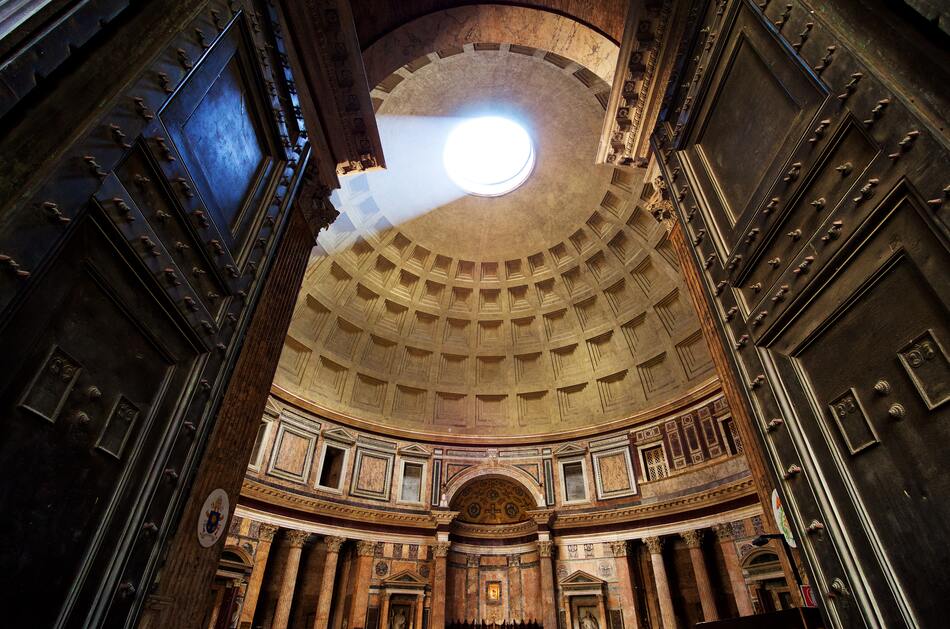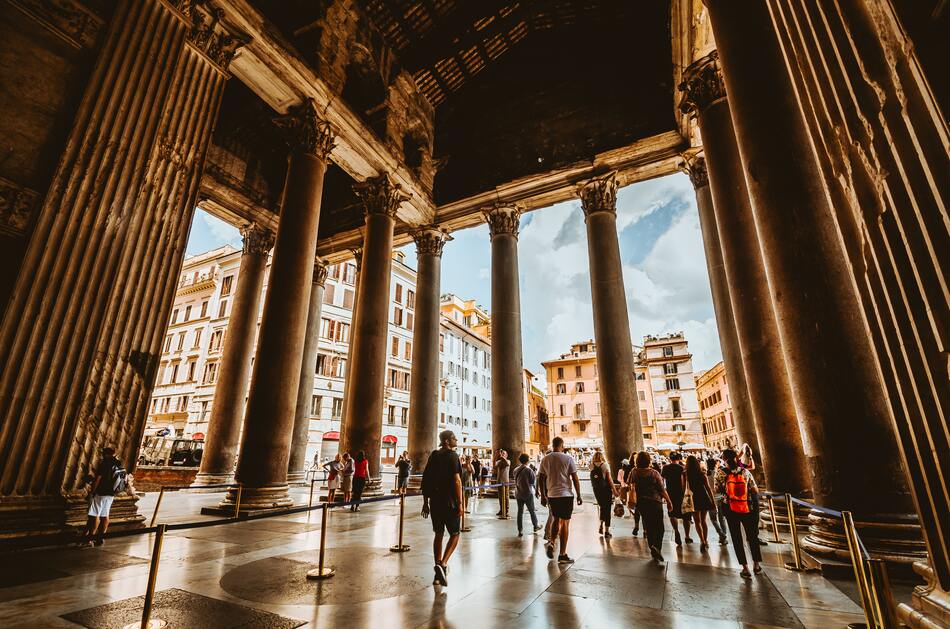The Pantheon is the best preserved of Rome's ancient buildings, with its wonderful dome, its marble, and original columns.
Map of the Pantheon Dedicated to all the gods of Olympus, the Pantheon was erected for the first time by Marcus Agrippa, advisor and son-in-law of Emperor Augustus.
The dedication occurred between 27 and 25 A.D., during the third consulate of Agrippa, as recorded in an inscription still visible on the front of the building:
M·AGRIPPA·L·F·COS·TERTIVM·FECIT, which means "It was built by Marcus Agrippa, son of Lucius, consul for the third time".

Actually, the inscription was repositioned after the complete reconstruction of the temple.
In fact, the original temple, with a rectangular shape, was destroyed by a fire in 80 A.D., restored by the emperor Domitian (read our article "Domitian on Haircare" and learn curiosity about the Roman Emperor!) and damaged again by a lightning bolt 30 years later.
The present-day building is a result of the reconstruction commissioned by Hadrian between 118 and 125 A.D. We know that Emperor Hadrian displayed an interest in architecture. In particular, he was interested in the surprising and scenic effects that could be created.
In the Pantheon, we can recognize his eclectic genius and exotic tastes.
The Pantheon's design features a portico with eight granite columns across the front, of Greek inspiration, (the same design as the rectangular temple), combined with a Roman cylindrical structure. The uniqueness of this combination is amazing.
When we cross the door immediately behind the portico, we see, with an incredible, surprising effect, the gigantic circular structure with a vaulted ceiling, the biggest ever built in Roman architecture.
The dimensions are massive and very well-balanced.
The diameter is exactly equal to the maximum height, 43.44 meters so its interior could accommodate a perfect sphere of that diameter.
The dome was probably designed to recall Olympus and the 7 niches all around the structure displayed the statues of the gods to whom the temple was dedicated.
The only light source is the Oculus or eye, a circular opening with a diameter of 8.2 meters.
The Oculus is considered to be the most extraordinary invention of the Pantheon's architecture and helped to create a heavenly light effect.
Check out our Rome Squares and Fountains Walking Tour and see the Pantheon live!
Another fascinating feature of the Pantheon's architecture is the technique used to build the dome. It is a single casting of concrete whose thickness diminishes as it rises.
It varies from 6.4 meters at the drum to 1.2 meters at the top, all around the oculus. Moreover, the concrete typically used by the Romans is not the same used in the structure of the dome. Instead, they created a special mixture to avoid the collapse of the dome under its own weight.
Actually, they used 3 different kinds of aggregates. In the first section, at the base of the dome, they used concrete with travertine marble, which is very heavy.
In the second section, they used concrete with tufa stone, which is less heavy.
For the last section, on top, they mixed concrete with pumice, the lightest stone.
The interior decoration of the hemispherical dome is made up of 5 concentric rows of coffers.
The legend of the rain is not the only one. According to another legend, the Oculus was created during the consecration ceremony of the Pantheon, in 608, when it was transformed into a church.
Legend has it that the pagan temple was haunted by demons (speaking about demons, have you already checked our Rome Angels and Demons Tour?), so when their place became a church they fled up creating a hole in the ceiling vault with their horns.
Actually, in 608 the temple dedicated to all the Gods (in the greek language PAN means all, and THEON means God) changed its name and its meaning becoming the Church of Mary and all the Martyrs.
Ready to book your experience? If you enjoyed reading this article, you cannot miss our Rome Squares and Fountains Walking Tour!


